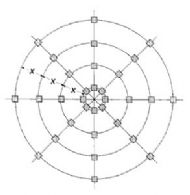Methodology
Very little information exists on the population abundance of Apodemus gurkha. In order to obtain quantitative information on relative densities in different habitats, trapping webs will be used, a technique that combines capture-recapture and distance sampling and makes it possible to cover large areas.
In this study we will sample two habitat types: natural habitat (rhododendron and coniferous forest) and human influenced areas (agricultural land). Mice will be marked individually with metal ear tags and released each time; this will be repeated over a period of five days per site. The number of replicate habitat areas sampled will depend on how much time is available but at least two samples will be taken per habitat type. A map with suggested study sites (marked by red dots) is available here: Map
Sampling Procedure: between 20 and 30 standard Sherman Live traps (22.9 x 7.6 x 8.9cm) will be placed in a web starting at intervals of 15 metres in a star shape increasing gradually to longer inter trap intervals so that a larger area is covered. The method allows for less than 100% probability of capture but it is more important to have several replicate sites. The traps will be baited with peanut butter and placed on the ground, within one metre of marker canes, along potential runways and next to natural objects.
As Apodemus gurkha is nocturnal, traps will be set at dusk then checked and reset at dawn; checking and resetting will be done on a twelve hour schedule (McWilliam, 2007). All caught animals will be identified, marked, their morphometric measurements taken, sexed and released. The team will undergo training with the related Apodemus sylvaticus here in UK, including safe handling, sexing and measuring. The team members will also learn how to distinguish Apodemus gurkha from Apodemus sylvaticus which also lives in Nepal.
One of the main threats listed on the IUCN website is that the rodents are collected for local consumption (Molur et al. 2005). This suggests that locals are aware of the presence of Apodemus gurkha and therefore may have knowledge that could improve our understanding of the rodent's ecology and habit. In order to assess the importance of this rodent in the community, locals in the vicinity of the trapping locations will be interviewed with the assistance of an interpreter.
 Trapping Web Trapping Web | | |
|  Expedition Nepal | sitemap | log in
Expedition Nepal | sitemap | log in





 Expedition Nepal | sitemap | log in
Expedition Nepal | sitemap | log in




